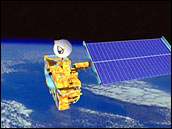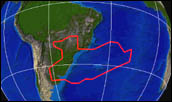

| The Duck | |||
On Sunday evening, December 19, the Terra flight operations team was surprised when the satellite’s High Gain Antenna spontaneously "safed itself." This antenna is the one that is used for routine communications with TDRSS satellites, including the downlink of Terra’s science data. The flight operations team quickly initiated a series of diagnostic tests to find out what went wrong. Quinn explains that there are built-in electronics in the High Gain Antenna that constantly monitor the electric current being drawn by the motor drive assembly, which controls the pointing direction of the antenna. If the electric current either exceeds or falls below a certain limit, then the antenna is preprogrammed to flag the problem and can decide to park itself until the flight operations team decides to restart it. In this case, telemetry data from the spacecraft indicated an anomalously high current passed through the motor drive assembly. "At first, only one axis on the antenna’s gimbal was affected and the other axis kept moving," Quinn recalls. "Then an additional fault detection shut down the other axis. We knew right away that this wasn’t due to a failure of the High Gain Antenna. So we began a brainstorming session in which we listed all the possible reasons why this could have happened." "It turns out, there is a semi-conducting opto-coupler in the High Gain
Antenna electronics that is susceptible to radiation transient single event
upsets," Grady explains. That’s a technical way of saying that the
satellite was exposed to a high dose of proton radiation in the Earth’s
magnetic field. Because electronic devices are getting smaller and smaller, they
are increasingly susceptible to interference or damage from radiation. |
 Terra's high gain antenna—the parabolic dish shown here above the spacecraft—transmits science data from the five instruments to scientists on the ground through a relay satellite. Without it, data from Terra would slow to a trickle. (Image and video by Reto Stöckli, Terra Project Science Office [4.7MB]) | ||
|
There are three regions over the Earth where scientists typically observe high levels of radiation—over the North and South Poles, and another region centered partly over Brazil and extending out over the Atlantic Ocean that scientists call the "South Atlantic Anomaly." In this region, scientists observe very high levels of proton radiation. The Terra flight operations team nicknamed the region "The Duck" because when you draw a contour map of the central part of the South Atlantic Anomaly where the radiation levels are highest, it resembles the profile of a duck. According to Grady, exposure to radiation in The Duck essentially fooled Terra’s High Gain Antenna into thinking that a fault condition existed in its Motor Drive Assembly. The antenna responded by turning itself off in order to prevent any possible damage from occurring. Interestingly, the Multi-angle Imaging SpectroRadiometer, or MISR, instrument
aboard Terra confirmed that the spacecraft was being exposed to high levels of
radiation over the South Atlantic Anomaly. By February, the instrument had
already been turned on and, although its aperture doors were still closed, MISR
was fully ready for operation. Every time Terra flew through The Duck, MISR
measured very high numbers of protons striking its highly sensitive detectors.
Intrigued, the MISR Team began counting these "hits" and produced the
first MISR image before they even opened its doors! |
 The region of the South Atlantic Anomaly was dubbed "The Duck" by the Terra flight operations team because when you draw a contour map of the central part of the anomaly, it resembles the profile of a duck. (Image by Mark Woodard, NASA Goddard Space Flight Center) | ||
 |
Even before the cover opened, the Multi-angle Imaging SpectroRadiometer (MISR) instrument aboard NASA's Terra spacecraft began making scientific measurements. The MISR cameras, designed to detect visible light, are also sensitive to energetic protons in Earth's upper atmosphere. With the cover closed, background levels of protons stand out. This map was created by specially processing MISR "dark" data taken between February 3–16, 2000, while the cover was still closed. Each orange picture element on the map shows one or more proton hits. (Image courtesy MISR Science team) | ||
Of course, Grady’s team spent a few days brainstorming and running diagnostic tests to be sure the South Atlantic Anomaly was the cause of the problem. Once convinced, and after making sure there was no danger to the antenna, they simply modified the computer program to restart the antenna gimbal subsequent to a radiation event. Quinn says the antenna still turns off over this region about once every 30 orbits, but then turns itself on again with no impact to mission operations. "There was quite a bit of effort expended to make sure we didn’t have these kinds of parts [overly sensitive to radiation anomalies] in the electronics," Grady states. "Of the tens of thousands of parts that we examined before launch, this one somehow got by us. This is where a robust spacecraft design is critical, as it allows the flight controllers to implement an operational modification with no resulting impact on the mission’s science. The antenna continues to work fine." With the antenna problem solved, Grady’s team began preparations for raising Terra to its final orbital altitude for mission activation. They didn’t know it yet, but the satellite had another surprise in store for them. |